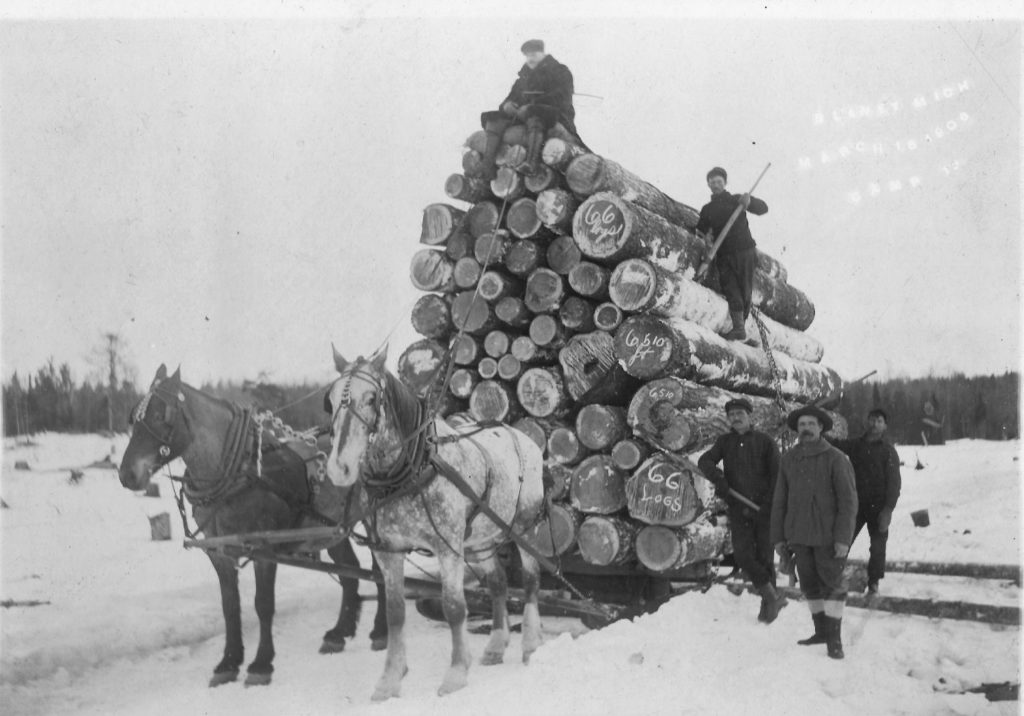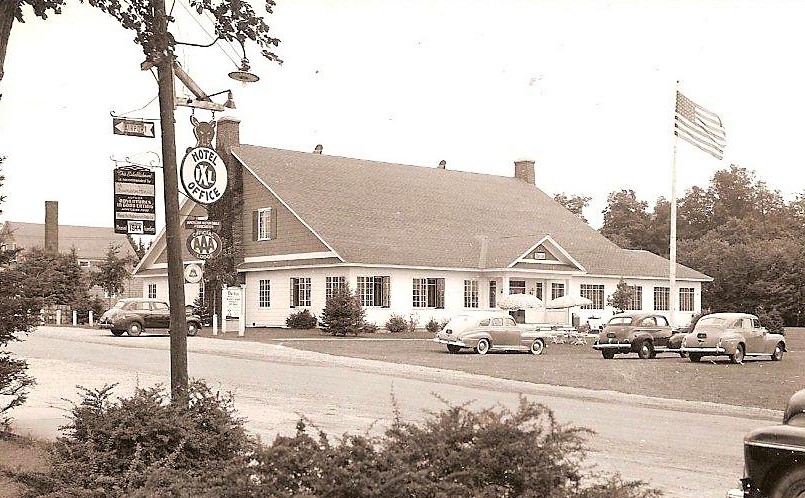
Above is an image of logging operations at Blaney dated March 16, 1908. SCHS photo courtesy Jerry Mattson Collection.
As a child growing up in Gulliver during the late 1950s and early 60s, our family would often travel via M-77 to Germfask to visit relatives. This entailed driving past the Blaney Park resort. During the summer, the resort was a bustle of activity. Cars were parked along the road and in front of all the cabins and places of business. Drivers had to be alert for pedestrians crossing the highway. Foursomes were seen strolling along the fairways with their golf carts in tow and walking on the greens of the well-manicured nine-hole golf course. The swimming pool too, was always crowded during the dog days of summer.
The history of Blaney Park can be traced back to William Mueller Jr., who purchased the land in 1902. Mueller was a businessman who dreamed of building a model logging town. He named his village Blaney after a friend who was the captain of a company vessel that sailed the great lakes. The first building to be erected at Blaney was the boarding house, later known as the lodge. This was followed by the construction of several cottages including residences for the carpenter, the storekeeper; the accountant and two cottages for the men who worked in the company office. A shingle mill was established along the banks of a pond, and 16 more cottages were constructed for the men who worked there. The workers brought in their wives and children and by 1905 a school was established.
A saloon was built across from the general store. However, the sale of bottled beer and whiskey were forbidden at the company watering hole, Drunken lumberjacks would not be tolerated at Blaney. The saloon opened at 8:30 am and closed at 9 pm. The establishment was closed on Sunday.
A large home was erected for the Mueller family and was known as the “big house.” A railroad was built which connected to the Soo Line. Branches were extended to the lumber camps throughout the property. Mueller finished building his model logging town in 1904, and all the while lumbering operations continued in earnest.
In 1909, the William Mueller Company holdings at Blaney were obtained by the Wisconsin Land and Lumber Company of Hermansville, Michigan. The company operated sawmills and a large flooring factory at Hermansville and timber from Blaney was turned into hardwood maple flooring and other wood products.
Another enterprise, the Blaney Land and Cattle Company was organized in October of 1919 for the purpose of creating a large cattle ranch at Blaney. Barns were raised and cutover land was fenced in. Plans were made for a complex of ranch buildings with the former Mueller home becoming the main ranch house. Two thousand five hundred head of western beef cattle were purchased from Arizona and shipped to Blaney, but the harsh Michigan winter took a heavy toll on the western cattle and the business venture failed.

The Inn at Blaney Park circa 1940s. The Inn’s knotty pine walls and hardwood floors were all constructed with local forest products. SCHS Photo.
By 1926, the transformation of the Blaney property into a vacation destination began to slowly take shape. Logging operations were concluded and much of the cutover land was let go in delinquent tax sales. The Earle brothers, G. Harold and Stewart E., majority stockholders in the Wisconsin Land and Lumber Company, made huge investments in the remaining 33,000 acres of the Blaney property to turn it into a first class resort. Bear Creek was dammed creating Lake Ann Louise. The cottages for the white collar workers were modernized and new cottages constructed. The former school was made into a play house for the children of vacationers. The “big house” of the William Mueller family was converted into a fine hotel and tavern. It was rechristened “Celibeth” in honor of Celia and Elizabeth Earle, the wives of the Earle brothers.
The property was enclosed with 63 miles of boundary fencing, and nearly 50 miles of roads were constructed throughout the park. The roads went through forest lands and game preserves and provided access to lakes and trout streams. Camps were constructed at several of the property’s seven lakes. Bridle paths were created along old logging roads. To protect the property from fire, ranger stations were established and fire towers erected. An airport was created in “a beautiful field of ample size” with aviation fuel and oils available on the grounds. Crews were busily engaged in landscaping the nine-hole golf course, along with laying out tennis, shuffleboard and horseshoe courts. An archery range complete with targets was also added along with a swimming pool. The northeast section of the property was turned into a bird and wildlife sanctuary. Dr. Karl Christofferson, a renowned ornithologist, fell in love with Blaney and spent over 25 years there during all of the seasons. He identified over 225 species of birds that visited Tee Lake at Blaney Park.
The resort formally opened for business in July of 1927 and could boast being the largest tourist development in the upper peninsula. Long term visitors arrived by train, plane and automobile. During its heyday, the Lodge at Blaney provided living quarters for 300 visitors and the Inn could seat 350 guests. Employment was provided to a staff of 130 people. Blaney relied upon elite visitors who came to the park and stayed for weeks at a time. Following World War II, tourism was dominated by visitors who came to the upper peninsula by automobile, traveling from one tourist venue to another. As the number of long terms guests dwindled, the park was unable to meet its overhead, and the resort was finally closed in 1965. Although the Blaney Park resort has passed into history, who knows what the future may yet hold for the former vacationer’s paradise.
